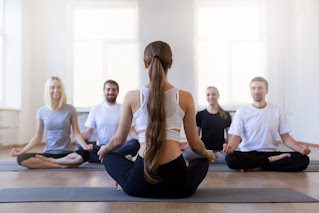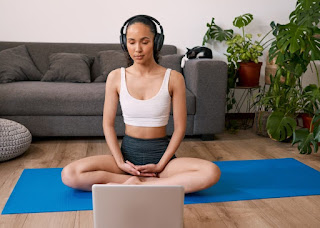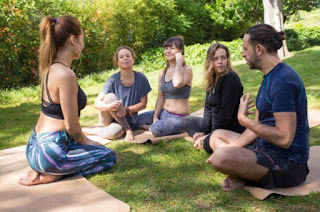Learn step-by-step techniques and guide to practicing guided meditation for beginners
We live in an endless cycle. We can get caught up in wondering what will happen next.
What
do we need to get done tomorrow? In the following month's project. This is
where we need to remember about the present. To connect with oneself.
Indeed,
you've heard of meditation. But have you heard of guided meditation? This
article teaches you a bit about guided meditation and its benefits.
Inner
peace, controlling one's emotions, improved focus in work or other tasks,
reducing the effect of stress or having less trouble coping with stress, and
increased interest and awareness are among the most notable advantages of
meditation.
To
learn how to meditate, you don't need to travel to a distant mountain or have a
teacher by your side, although you may soon consider signing up for a
meditation retreat because there is something addictive about them.
By following these articles to the end, you will see that you will get results.
What
is Guided Meditation
Guided
meditation is a Meditation technique in which the person in charge of
constructing this meditation walks us through each situation step by step.
Specialized
guided meditations on a positive theme help you achieve a level of healing,
release, and awareness that leads to a particular state of thoughts and
consciousness.
In
guided meditation, you surrender control and open yourself up to guidance.
You
listen to a voice that guides you through a meditation experience. It grabs you
by the hand and guides you into higher states of awareness, guiding you away
from the daily thinking cycle.
The
format and subject matter of guided meditations also differ. You must discover
a voice and a tempo that you are comfortable with.
For
experienced meditators as well, guided meditation may be quite beneficial,
particularly if you find it challenging to quiet your mind and concentrate on
your own.
Additionally,
guided meditations offer fresh ideas that you may incorporate into your daily
routine.
What
Is the Difference between Meditation and Guided Meditation
Both
guided and unguided meditation aim to help us discover inner calm despite their
differences in form.
There is nothing excellent or wrong in following our emotions; meditation leads us internally and forward in existence.
Whether
we pick to exercise silent or guided meditation, we frequently begin by
desiring to feel peaceful, calm, and at ease.
Guided Meditation
Anyone
just beginning their meditation journey can benefit from guided meditation, but
even seasoned practitioners can gain from quality guided meditation.
We
may practice by ourselves at times or prefer following someone
else's direction at other times.
Guided
meditation shares many similarities in this regard.
It's
crucial to remember that a teacher of guided meditation is only there to clear
the path and set the appropriate environment.
It
is totally up to each of us to choose to experience something like this.
Unguided Meditation
In
silent or unguided meditation, you focus your attention on any meditation
object without the assistance of a teacher.
This
might be a mantra, your breath, or a chakra on which you center your attention.
As
the name implies, there is silence outside of you, and no one is guiding you
during the meditation.
You
can meditate anywhere, at any time, without a guide. As a result, you may
utilize meditation at any moment to unwind, get perspective, and clear your
thoughts.
Examples of Guided
Meditation Practices.
·
Follow the instructions.
·
Use a prepared and structured meditation.
·
Attention is focused on the voice of the
leader.
·
We are reminded to stay focused and
concentrated.
·
Uses guided breathing and visualization
exercises.
·
The pace and structure are controlled by
someone else.
·
The practitioner could be distracted by the
voice.
·
The meditation script may not currently meet
our needs.
·
You may not be able to connect to the
leader's line.
Are Guided Meditations Good For
Beginners
To
the question, Are Guided Meditations Good for Beginners, I firmly say Yes.
However,
it would be best if you didn't worry because guided meditation is advised for
beginners.
After
all, it is so frequent. Beginning students have the freedom to sit down and
quiet their minds during guided meditation sessions.
The
guide will use a series of instructions and stages to help you meditate
methodically.
Being
directed by a voice during our meditation is one of the most potent ways to
connect with oneself, achieve a deeper state of peace and relaxation, and
relieve stress.
Meditation
is difficult for beginners without guidance. As a result, I recommend that you
use a guided meditation, an app, or both.
This
is simple and guarantees that you have to assume less while meditating. Just
take a seat and listen.
Thoughts
begin to run through your mind as soon as you sit on your cushion or on that
fantastic chair.
It
may not be easy to let go of such ideas at first, especially if you are
a beginner to meditation. That is why a guided meditation is a pleasant
and clean way to begin.
Benefits
of Guided Meditation for Beginners
If you meditate on a daily basis, you will most certainly notice a variety of advantages to your physical and mental health.
This
is true for all forms of meditation, including guided practices.
Meditation
enhances our mood and how we cope with emotions, boosts our good personality
qualities, increases our capacity to focus, and clarifies our thinking.
The
degree to which all of this occurs is not spectacular, but it is plainly
measurable.
Guided meditations
have other benefits:
1. Reduces
stress and anxiety.
2. Improves
focus and concentration.
3. Promotes
emotional health.
4. Enhances
self-awareness.
5. Improved
self-awareness
6. improves
the quality of sleep
7. Stimulates
Blood Pressure and Digestion
8. develops kindness
9. Memory
loss due to age can be reduced
10.
It can help fight addictions
Step-by-Step
Guide to Practicing Guided Meditation
During meditation, you take a minute to relax and avoid being consumed with the ideas that race through your mind.
Thoughts
come on a continual basis; we observe events, have thoughts about them, and
draw connections between various thoughts, events, and feelings.
When
you find yourself thinking, you return your focus to the present moment. In
this manner, you can boost your attention span and focus.
While
meditating, maintain a decent posture, such as a straight back, to avoid back
issues during and after meditation.
However,
not everyone finds this easy or pleasant, especially if they are sitting on a
hard surface.
Here are some Step-by-Step Guide to Practicing Guided
Meditation
1. First,
Find a Comfortable Space.
2. Choose
the right environment.
3. Importance
of a quiet and comfortable place.
4. Start
meditating for just two minutes a day.
5. Do
it first thing every morning.
6. Set
Your Intention.
7. Take
Time to Relax the Body.
8. Pay
Close Attention to Your Senses.
9. Investigate
What You're Feeling.
10.
Keep Coming Back to the Body.
11.
Don't get caught in the trap.
Most
people worry about where to sit, how to sit, whether to use a pillow, how to
meditate correctly, and so on.
12.
Don't be afraid of mistakes in meditation.
13.
Don't try to keep your mind blank and stop
your thoughts.
14.
Stay with your feelings and thoughts for a
while.
How to
Do a Guided Meditation
Guided Meditation restores a state of calm in the body, aids in regeneration, and avoids new damage from the physical impacts of stress.
This
meditation is one of the most effective ways to avoid mental diseases and
preserve overall mental health.
Let's
look at a broad guide to meditation that you may utilize at any time and from
any location.
Anyone
can accomplish it, including total beginners, with a bit of practice. This
guide is applicable to any meditation.
1. Find A Quiet And Peaceful
Place To Meditate.
The
first step is to find a peaceful, quiet spot to meditate. Refrain from taking
any unneeded pauses, mainly if you are not familiar with or have not yet
mastered the imperial meditation. Don't forget to close the window, turn off
the phone, and block any possible noise sources.
2. Choose
Appropriate Clothing.
Step
two: Wear comfortable clothes. You want to keep your clothes from restricting
or creating discomfort during meditation. I recommend dressing loosely, with no
tight-fitting garments or underwear.
3. Watch Out For A
Full Stomach.
The
third stage is more of an advice recommendation. I cannot recommend meditating
with a full stomach. You won't be able to rest or focus as much, which may be
unpleasant. The most straightforward technique to meditate is to choose an
appropriate moment when you are not hungry, full of food, or high on water.
4. Choosing a
Suitable and Ideal Position
The
fourth stage is locating an appropriate position for meditation. You can pick
out any position that is comfortable for you and works best for the meditation.
You can sit on the ground, on a mattress, on a chair, or lie down. If you
lie down, be careful now not to doze off, as this could prevent you from
meditating.
5. Close Your Eyes.
The
sixth step is the most challenging. Please close your eyes and keep them closed
during the meditation.
6. Breathing
The
sixth step Involves breathing. Begin taking calm, deep breaths. Ideally,
breathe into your stomach (diaphragm), although this is not always possible.
Concentrate on breathing gently and deeply. You may easily detect how your
stomach rises with breathing and then falls again with an exhale.
7. Conscious Observation
of Your Breath
The
seventh step is the most difficult of the entire meditation, but don't give up
if you don't get it right away. It just requires time and learning. And
sufficient practice. A lot of people struggle with it, do not know how to
meditate, and eventually quit. Before we begin, I want to encourage
you not to give up if you fail immediately. It only takes practice and time.
Tips for Beginners in Guided Meditation
1.
Meditate At The Same Time Each Day.
The
most efficient method to include meditation into your daily routine is to do it
at the same time every day, following a regular rhythm.
2.
Start By Sitting For Just 2 Minutes.
The
best way to start meditating is to begin with small sessions of two minutes
each day and gradually increase them.
3.
Meditation Purpose
To
begin, ask yourself why you want to meditate and what you want to achieve.
4.
Don't worry about how to meditate - start
Most
people are confused about how and where to sit, whether to use a pillow and where
to put their hands.
But
in the beginning, it is not so important, so don't be discouraged; start. You
will soon discover that you can find the answer to many questions yourself.
5.
How Long To Meditate
The
idea of sitting still for 20 minutes can be daunting, so start slow and easy,
with just 2 minutes to begin with. You'll be surprised how quickly they slip
away, and you'll want to extend the time yourself.
6.
Comfortable Clothes
There
is no prescribed type of clothing or color. Dress in clothes that make you feel
good.
7.
Do I Have To Sit In the Lotus Position
When
you think of the word meditation, do you think of a person sitting with their
legs tangled up like a pretzel? Don't be discouraged; you don't have to sit
like this at all! Any comfortable sitting position with an upright spine,
relaxed neck, and shoulders is acceptable.
8.
Guided Meditation
If
you're still confused about how to start, try a guided meditation to begin with
and get yourself a recording to play.
Common
Challenges and How to Overcome Them
With guided meditation, you may actively educate your mind to concentrate, but it will take work and dedication.
Dealing
with obstacles is also a component of the training process. The following are
some typical difficulties that each practitioner of meditation encounters:
1. Transient ideas
and endless chatter
The
thoughts desire to stray. It is like a wild horse going at its speed, leaping
from one notion to the next.
Even
while this could irritate you and cause you discomfort, keep in mind that this
is how the mind works, and as a mindful practitioner, you start to identify and
deal with this.
What, then, do you
do?
Sit with it, observe, and unwind.
2. Set up a timer:
During
meditation, we might occasionally become distracted by our worry of running out
of time.
Set
a timer for your meditation session to help you stay clear of this. It will be
easier for you to concentrate on the exercise without having to look at the
timer all the time if you know how long you have left.
3. The struggle
between breath and thinking
Generally
speaking, people are more conscious of their thoughts than their breathing.
Your thoughts and feelings will try to pull you away as you begin to focus on
your breathing.
You
have uneven breathing, a decline in focus, restlessness, and a loss in optimism
as a result.
What, then, can you
do?
– Recognize, accept, and take a deep breath.
4. Anxiety and
soreness in the body
Nobody
finds meditation to be an easy task. Your meditation practice can be difficult
due to a variety of distractions, including physical disturbances, bodily
sensations like tingling and tightness in the body, difficulties
sitting in a posture, restlessness, uncertainty, tension, and mental disorders
like voices or images.
What, then, can you
do?
Observe, acknowledge, and proceed.
5. A lack of
commitment and emotional investment in the result
A
person becomes more excited about the practice of meditation when they see the
changes that occur during the early stages of the training.
But
eventually, things get slower, and the initial zeal is rapidly replaced by
apathy, a lack of drive, and a refusal to carry on.
What, then, are your
options?
— Treat yourself more kindly, give up the urge to "achieve" anything,
and have faith in the process.
Conclusion
All
circumstances can benefit from guided meditations, which are especially helpful
for beginners.
I hope that my article has been helpful to you, and I'm delighted to
have walked with you as you take your first steps toward a career in
meditation.










